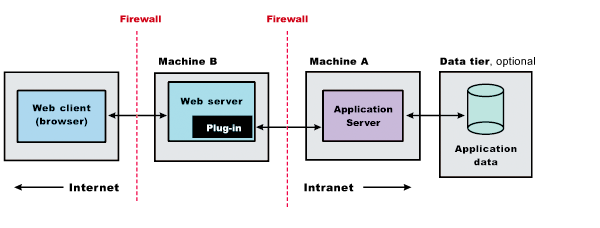Configure web server plug-ins
WebSphere Application Server supplies a unique binary plug-in module for each supported web server. The plug-in configuration file, which the WAS products create and maintain, interacts with the binary module to provide information about the application server configuration to the web server. The web server uses the information to determine how to communicate with the application server.
Install the following products:
- A supported web server, such as IBM HTTP Server
- Web Server Plug-ins for IBM WAS
- WebSphere Customization Toolbox
See Install the application serving environment.
See Web server plug-in policy for WAS, to verify...
- What plug-in versions are installed on local or remote web servers
- Determine if the installation complies with supported configurations
The Web Server Plug-ins Configuration Tool configures the web server for communicating with the application server and creates a web server configuration definition in the application server if possible. This tool is supported only on AIX, Linux, and Windows. As an alternative to using the Web Server Plug-ins Configuration Tool GUI, we can use the pct command-line tool with a response file to configure a web server.
When multiple profiles exist, we can select the profile that the Web Server Plug-ins Configuration Tool configures. See Plug-ins configuration for a description of the flow of logic that determines how to select the profile to configure.
Some topologies, such as the web server on one system and the application server on another system, prevent the Web Server Plug-ins Configuration Tool from creating the web server definition in the application server configuration directly on the remote system. In such a case, the tool creates a script that we can copy to the application server system. Run the script to create the web server configuration definition within the application server configuration.
Topology scenarios
Scenario 1: Local application server profile
WebSphere application server and the web server are on a single system or logical partition.

A local distributed installation includes the Web server plug-in, the web server, and a managed application server on the same system:

See Configure a web server and an application server profile on the same machine.
Scenario 2: Remote
WebSphere application server and the web server are on separate machines or logical partitions.

See Configure a web server and an application server on separate machines (remote).
Scenario 3: Remote
Multiple standalone application servers are on one system, and each application server has a dedicated web server on a separate system or logical partition.

See Configure multiple web servers and remote standalone application servers.
Scenario 4: Local custom profile
A managed node and the web server are on the same system or logical partition.
A local distributed installation includes the web server plug-in, the web server, and the managed custom node on the same system:

See Configure a web server and a custom profile on the same machine.
Scenario 5: Local deployment manager profileA Dmgr node and the web server are on a single system or logical partition.
A local distributed installation includes the web server plug-in, the web server, and the application server on the same system:

See Configure a web server and a dmgr profile on the same machine.
What to do next
See Web server configuration for more information about the files involved in configuring a web server.
See Edit Web server configuration files for information about how the Web Server Plug-ins Configuration Tool configures supported web servers.
Subtopics
- Web Server Plug-ins Configuration Tool
- Web server configuration
- Configure a web server and an application server profile on the same machine
- Configure a web server and an application server on separate machines (remote)
- Configure multiple web servers and remote standalone application servers
- Configure a web server and a custom profile on the same machine
- Configure a web server and a dmgr profile on the same machine
- Configure a web server plug-in using the pct tool
- Create or update a global web server plug-in configuration file
Related: